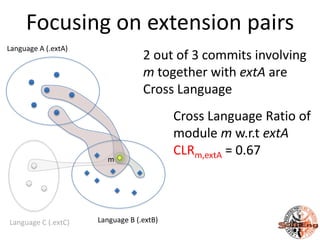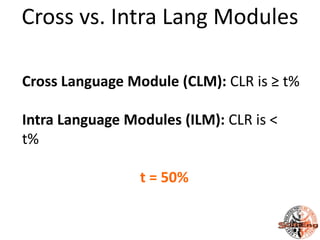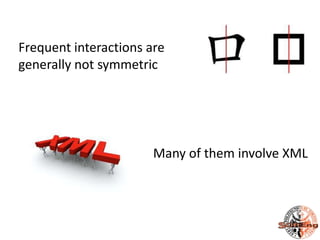Language Interaction and Quality Issues: An Exploratory Study
- 1. Languages interaction and possible effects: an exploratory study Antonio Vetrò - Federico Tomassetti Marco Torchiano - Maurizio Morisio
- 2. No one writes in a single language anymore. Even trivial applications have a general-purpose language, SQL, JavaScript, CSS, and dozens of frameworks, each of which includes an external DSL Wampler 2010
- 3. How do those languages interact? Is that interaction problematic?
- 4. Research questions RQ1 How much interaction is there between the languages used in a project? RQ2 Which language pairs interact more? RQ3 Are Cross Language Modules more defect- prone than Intra Language Modules?
- 5. Plan • Define a measure for the level of interaction among languages • Investigate interaction vs. defect proneness • Perform a case study
- 6. The Case Study Apache Hadoop, which is a software to support distributed data storage and processing. Used in many real applications (e.g., Yahoo, Facebook).
- 7. Commit types Language A (.extA) Cross-Language Commit (CLC) Intra-Language Commit (ILC) Language B (.extB)
- 8. RQ1 How much interaction is there between the languages present in a project? Metric: Percentage of Cross-Language Commits • All type of commits (RQ1.1) • Commits divided by activity type (e.g., improvement, bug fixing, new feature) (RQ1.2) All Bug Improv New Sub Task Test (RQ 1.1) ement Feature task 0.53 0.12 0.26 0.30 0.45 0.26 0.05
- 9. Cross Language Ratio Language A (.extA) 3 out of 4 commits involving m are Cross-Language Cross Language Ratio of module m CLRm = 0.75 m Language C (.extC) Language B (.extB)
- 10. Interaction level of a language • Cross language ratio of an extension (language)
- 11. RQ2 Which extensions interact more? Metric: CLRext Considering one extension versus all the other extensions (RQ2.1) CLRext Nr files Extension 0.96 49 c 0.87 114 sh 0.72 75 properties 0.71 320 xml 0.59 4328 java
- 12. Focusing on extension pairs Language A (.extA) 2 out of 3 commits involving m together with extA are Cross Language Cross Language Ratio of module m w.r.t extA CLRm,extA = 0.67 m Language C (.extC) Language B (.extB)
- 13. Interaction level of a pair • Cross language ratio of an extension w.r.t. another extension – Asymmetrical measure!
- 14. RQ2 Which extensions do interact more? Metric: CLRextA,extB Considering the most interacting ordered pairs of extensions (RQ2.2). extA/extB C Java Properties Sh C - 0.51 0.10 0.50 Java 0.01 - 0.28 0.04 Properties 0 0.54 - 0.36 Sh 0.09 0.22 0.24 - Xml 0.04 0.52 0.43 0.24
- 15. Cross vs. Intra Lang Modules Cross Language Module (CLM): CLR is ≥ t% Intra Language Modules (ILM): CLR is < t% t = 50%
- 16. RQ3 Are Cross Language Modules more defect-prone? Metric: Odds ratio of CLM with/without defects , ILM with/without defects - all module regardless of extension (RQ3.1) - by extension (RQ3.2) ILM ILM CLM CLM p-value OR no def. def. no def. def. all 1891 225 2875 89 <0.001 0.26 c 2 0 46 1 1.000 Inf java 1692 201 2239 25 <0.001 0.09 properties 19 1 45 7 0.429 2.92 sh 10 5 64 13 0.162 0.41 xml 96 11 184 24 0.851 1.14
- 17. RQ3 Are Cross Language Modules more defect-prone? Metric: Odds ratio of CLM with/without defects , ILM with/without defects Considering interaction between specific ordered pairs of extensions (RQ3.3). C Java Properties sh XML C - Inf 0 0 Inf Java 2.79 - 0.32 0.43 0.96 Properties Inf 1 - 12.08 0.94 Sh 3.55 4.45 17.17 - 7.44 Xml 3.83 0.95 3.22 4.73 - In bold significant values
- 18. Threats • Confounding factors: age and size of modules • Usage of proxy for interaction between artifacts • Apache Hadoop representativeness • Renaming of modules
- 19. Conclusions
- 20. Language interaction depends on the type of activity
- 21. Frequent interactions are generally not symmetric Many of them involve XML
- 22. In general language interaction is not related to higher defect proneness, see Java Though several language pairs have CLMs significantly more defect prone then ILMs, see C
- 23. Questions? Languages interaction and possible effects: an exploratory study Antonio Vetrò - Federico Tomassetti Marco Torchiano - Maurizio Morisio
Editor's Notes
- #6: NB: file type = extension!!
- #11: CLR_{m,ext} = \\frac{\\# CLC_{m,ext}}{\\# CLC_{m,ext} + \\# ILC_{m,ext}} CLR_{ext} = \\frac{\\displaystyle\\sum_{m \\in ext}{CLR_{m,ext}}}{\\# m \\in ext} CLR_{extA,extB} = \\frac{\\displaystyle\\sum_{m \\in extA}{CLR_{m,extB}}}{\\# m \\in extA}
- #14: CLR_{m,ext} = \\frac{\\# CLC_{m,ext}}{\\# CLC_{m,ext} + \\# ILC_{m,ext}} CLR_{ext} = \\frac{\\displaystyle\\sum_{m \\in ext}{CLR_{m,ext}}}{\\# m \\in ext} CLR_{extA,extB} = \\frac{\\displaystyle\\sum_{m \\in extA}{CLR_{m,extB}}}{\\# m \\in extA}
- #15: CLR_{m,ext} = \\frac{\\# CLC_{m,ext}}{\\# CLC_{m,ext} + \\# ILC_{m,ext}} CLR_{ext} = \\frac{\\displaystyle\\sum_{m \\in ext}{CLR_{m,ext}}}{\\# m \\in ext} CLR_{extA,extB} = \\frac{\\displaystyle\\sum_{m \\in extA}{CLR_{m,extB}}}{\\# m \\in extA}























